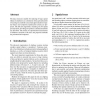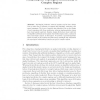SIGMOD
1994
ACM
14 years 9 months ago
1994
ACM
Spatial joins are one of the most important operations for combining spatial objects of several relations. In this paper, spatial join processing is studied in detail for extended...
ADBIS
1994
Springer
14 years 9 months ago
1994
Springer
The data structures suitable for indexing of large spatial objects in databases are considered. Some generalizations of existing tree methods concerned approximation of spatial ob...
ER
1998
Springer
14 years 10 months ago
1998
Springer
Abstract: Currently, there are strong efforts to integrate spatial and temporal database technology into spatio-temporal database systems. This paper views the topic from a rather ...
DEXA
1999
Springer
14 years 10 months ago
1999
Springer
When spatial objects are replicated at several sites in the network, the updates of a long transaction in a specific site should be propagated to the other sites for maintaining th...
DASFAA
1999
IEEE
14 years 10 months ago
1999
IEEE
In this paper, we will introduce a method of spatial presentation of georeferenced data in a three-dimensional space. Photographs, Quicktime VR's, videos, and computer graphi...
SSD
2001
Springer
14 years 10 months ago
2001
Springer
The need to access spatial data at multiple levels of detail is a fundamental requirement of many applications of geographical information, yet conventional spatial database access...
GIS
2009
ACM
14 years 10 months ago
2009
ACM
Apart from visualization tasks, three-dimensional (3D) data management features are not or only hardly available in current spatial database systems and Geographic Information Sys...
DASFAA
2003
IEEE
14 years 11 months ago
2003
IEEE
Modern database applications including computeraided design (CAD), medical imaging, or molecular biology impose new requirements on spatial query processing. Particular problems a...
DEXA
2004
Springer
14 years 11 months ago
2004
Springer
Topological predicates between spatial objects have always been a main area of research on spatial data handling, reasoning, and query languages. The focus of research has definit...
ADC
2004
Springer
14 years 11 months ago
2004
Springer
Aggregating spatial objects is a necessary step in generating spatial data cubes to support roll-up/drill-down operations. Current approaches face performance bottleneck issues wh...



